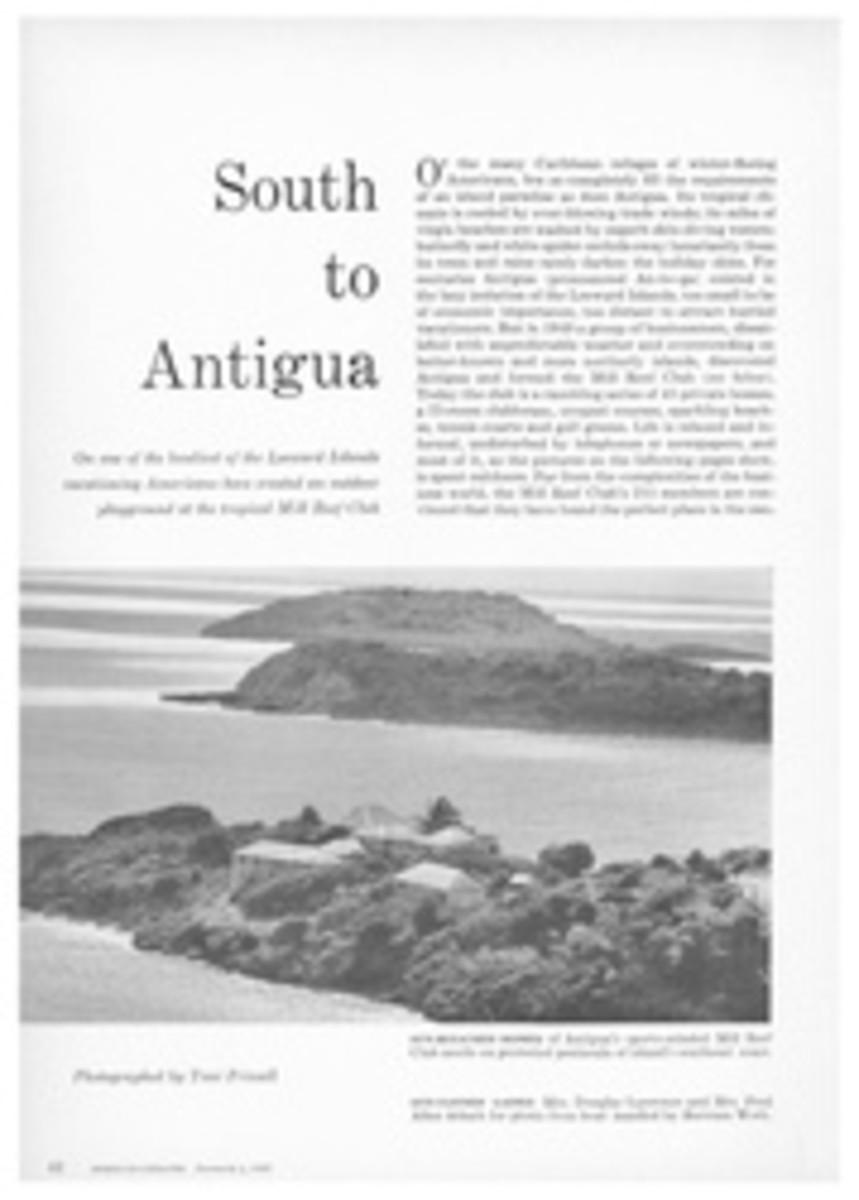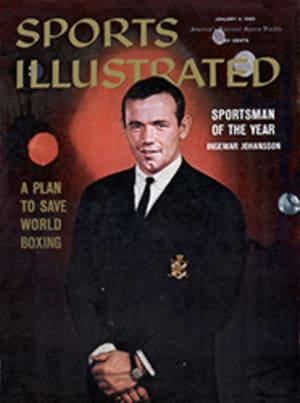
THE BEST TEAM YOU EVER SAW
It was not the best football game ever played, but it was won by probably the best football team that aver played. A superlative performance earned the Baltimore Colts their world title for the second straight year. Their defense, the best in the business, stifled the good Giant attack for 59 minutes and 28 seconds, allowing New York a touchdown when the game was already well won, and this fourth-quarter team exploded once again in the final period to score 17 points against a defense that can now only be rated as pro football's second best.
But for nearly three-quarters of this very tough game, the New York Giants, using a percentage defense set up by their brilliant assistant coach, Tom Landry, held the Colt attack well in check. "We decided to gamble on Lenny Moore," Landry explained. "You can't cover all of the Colt offensive weapons. We wanted to stop their running game and provide double coverage on Raymond Berry and Jim Mutscheller. That meant we had to cover Moore with one man—Lindon Crow. We figured that Moore might, in the course of the game, get two touchdowns, but we figured that we could get more than that. I thought we might win by something like 17-14 or 21-17 if the defense worked. And it did work, too."
Moore got one of the touchdowns expected of him in the Colts' first offensive series. Unitas called a pass to Berry, but the league's best receiver was covered tenaciously by two Giants. So Unitas faked a throw to Berry, then turned and whipped a hard, fast pass to Moore. Moore hesitated briefly, then faked out and cut in cleanly, and he caught the pass three steps ahead of Crow on the Giant 35 and went in for the touchdown unscathed.
This was to be the pattern of the Colt success later in the game. Seldom did Unitas try long passes, and the Colt running game was effectively throttled by the strong Giant line and linebackers. ("We think short to get long gains," Baltimore Coach Weeb Ewbank explained. "And you don't like to throw long against a guy like Patton. He covers an awful lot of ground after the ball is in the air.")
The Giant attack was moving well during the first half. Charlie Conerly took advantage of the tight 4-3 defense the Colts opened with to send Gifford and Webster wide around the ends on quick pitchouts. When he found that the Colt middle linebacker, Dick Szymanski, was flying out to the flank the moment he made a motion to throw wide, Conerly faked the throw and handed the ball to Triplett, who rumbled through a gaping hole in the middle of the Baltimore line and ran 28 yards to the Colt 16. The Colts adjusted their defense, setting the corner linebackers to stop the sweeps, and the Giants finally settled for the first of the three field goals kicked by Pat Summerall.
The second Giant field goal came seconds before the end of a second quarter which was played on even terms. Conerly, throwing into the zone defense of the Colts, was completing key passes well, but when he moved his team downfield the Colt defense grew tighter and tighter as the area in the zones covered by Colt defenders dwindled. It was late in this period that the first of some key injuries to Giant personnel occurred. Jim Patton injured the arch of his left foot and limped out of the game. He was replaced by Bill Stits, a good defensive back, but his loss was to cost the Giants dearly in the violent fourth quarter.
Now, however, with the Giants covering Colt receivers so well that time and again Unitas was forced to take a loss when he could not find an open target, Patton's absence did not seem so vital. Immediately after Patton left the game, Unitas was thrown for losses on successive plays, and the Giants ended the period by driving 52 yards in five plays to set up Summerall's curving 37-yard field goal, which Colt Defensive Captain Gino Marchetti vehemently maintained had gone wide.
A third Summerall field goal gave the Giants the lead early in the third period, and at this point in the game the New Yorkers appeared to have established control. ("This is a game of momentum," Landry said later. "We had good momentum then. We were moving the ball well. Charlie wasn't getting as much protection as he has in the past, but Schnelker was doing a great job and we were rolling. When we lost that momentum, the Colts took it over and we never got it back.")
The Giant momentum died late in the third period on the same kind of play which cost them the championship in the sudden-death playoff in 1958. With fourth down and a yard to go on the Baltimore 28, the Giants went for the yard instead of trying another field goal. Alex Webster took a quick hand-off into the left side of the Colt line and was stopped cold. The Colts took over and built up a momentum which grew with the speed of a snowball rolling downhill.
Unitas, who had been having poor success trying to run against the Giants, now went into a double wing T formation in order to pass. This left only his fullback for pass protection and, had Patton been available in the deep secondary, the Giants might have chased Unitas out of this formation by blitzing—sending the linebackers in after him to get him before he could throw. But Patton was on the sidelines, and the Giants needed their linebackers to help on pass defense. The Colt double wing forced them into covering Berry and Moore each with only one man, and Unitas, early in the fourth period, hit Berry for a 17-yard gain, then passed to Moore on a quick slant. Moore caught the ball on a dead run, moving with the high knee action which makes him very difficult to tackle, and Crow, coming in fast, dived at Moore's legs and caught a knee on the side of his head. Stunned, he fell away from the tackle, and Moore went on down to the Giant 14. Landry's gamble on Moore's getting two touchdowns was very nearly exactly right, for he scored one and set up this one, scored by Unitas on a roll-out and run from the Giant four-yard line. Unitas got a strong block from Moore; he ran to Crow's side and Crow, had he not been still dazed from the blow on the head, might have reacted quickly enough to reach Unitas.
The touchdown gave the Colts a 14-9 lead, but more importantly it shifted the control of the game to Baltimore. The Giants now began to gamble with the long pass, a fatal mistake against the very fluid, very quick zone defense of the Colts.
Under tremendous pressure from a Colt defensive line which was consistently beating the Giants on the snap of the ball, Conerly threw a long pass down the middle which was intercepted by Andy Nelson and returned to the Giant 14. If the measure of a great team is its ability to score in the wake of an opponent's mistake, the Colts proved their ability here. Unitas sent Berry on a pattern which took him into the Giant end zone, bringing a Giant defender with him, then tossed a short pass to rookie End Jerry Richardson, who ran 12 yards for the touchdown. Again this pass was to the side where Patton normally defends.
The zone defense the Colts use can be beaten, but only by very precise execution of pass patterns complemented by precise passing. "The Browns beat it by making no mistakes," Landry said. "They never hung a ball up there and they threw short and under the Colt backs and they threw exactly. If you throw poorly into this kind of defense, you'll get interceptions. The Colts can gamble on you getting an occasional hard touchdown because they can score so quickly themselves. You need a great offense if you use this kind of defense."
In the face of the inexorable rushing of Art Donovan and Gene Lipscomb and Gino Marchetti and Don Joyce, Conerly was not throwing exactly. On the Giants' first series after the third Colt score, he threw off balance, far downfield toward Gifford, and Johnny Sample, a tremendously fast Colt defensive back, raced in front of Gifford to intercept the pass and return it 42 yards for a touchdown.
"I was playing the middle in the three-man-deep zone," Johnny said. "I saw Gifford come into my zone and I looked for the ball and I knew I could beat him to it."
He picked off another pass, this one thrown by Gifford, to set up the field goal which closed the Colt scoring. Again he did it on a dead run, free to play the ball in the zone defense. The Giants scored a meaningless touchdown after that, and it ended 31-16.
Strangely enough, the Giants went into this game with almost overweening confidence. The two dressing rooms before the kickoff were dramatically different. On the New York side players were relaxed. Big Rosey Grier napped on the floor, and the other players dressed with no sign of tension or worry. Theirs was an attitude of quiet assurance, and you felt, watching them, that these old pros were not entertaining a thought of defeat.
The Colt dressing room was electric. A photographer, trying for pre-game pictures, got only a glimpse through a door quickly opened and as quickly shut in his face. "Not now," Ray Berry told him. "They are pretty keyed up. You might make some of them mad." The Colts were fully dressed 30 minutes before taking the field, and they sat before their lockers in strained silence.
After the game the ebullient Baltimore fans made an earnest attempt to tear down the steel goal posts and more or less succeeded. Vice-President Nixon, who visited both dressing rooms and even inquired after Mel Triplett's sore throat, was surrounded by a small knot of autograph seekers as he left the stadium. "Nixon and Unitas for President!" one Republican fan shouted, and Nixon laughed. "Not a bad team," he commented. "But if we do it, I'll let Johnny call the signals."
PHOTO
HERO UNITAS (19) cocks arm to throw to receiver Berry (82), who has stolen a vital step on Giant defender Dick Lynch (22).
PHOTO
60-YARD RUN to touchdown by Lenny Moore, another key to Colt victory, follows a brilliant pass from Quarterback Unitas.
PHOTO
JOHNNY SAMPLE, CAT-QUICK COLT DEFENDER, LEAPS TO INTERCEPT A CONERLY PASS
PHOTO
THE COLT DEFENSE, THE BEST THERE IS, THROTTLES A GIANT RUN BY ALEX WEBSTER

